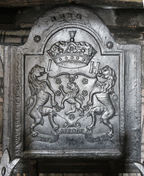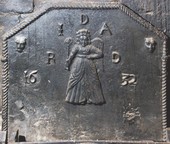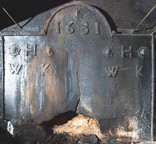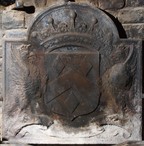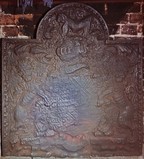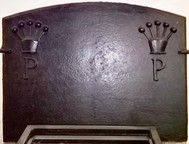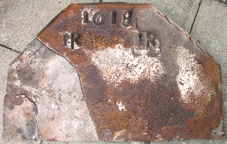-
972
Description: Arched rectangular shape with ovolo-moulded edging and extensions to sides and top; central shield bearing arms with lion rampant supporters and motto scroll beneath; above, a marquesal coronet; date (over-pressed) in extension above main panel; inserted initials (slightly over-pressed) on either side of coronet.
Notes: The arms are of Henry Pierrepont, marquess of Dorchester and earl of Kingston-upon-Hull, of Thoresby Hall, Nottinghamshire (blazon: argent semi of cinquefoils gules, a lion rampant sable), with the motto: Pie Repone Te (Place yourself piously), a pun on the name, Pierrepont. Confusingly, the marquisate of Dorchester was created twice for members of the same family. In 1645 it was created for Henry Pierrepont, 2nd earl of Kingston-upon-Hull, becoming extinct on his death without surviving male issue in 1680. It was created again for Evelyn Pierrepont, the 5th earl of Kingston in 1706 who was subsequently elevated to the dukedom of Kingston in 1715. The original casting may therefore have dated to between 1645 and 1680 or between 1706 and 1715. The initials may be related to the Halls, the 2nd Duke of Kingston's mother's family, and were added to a subsequent casting which, in turn, could have pre-dated the addition of the dated extensions which have obliterated 'Dutch'-style dolphins known to have surmounted the original.
Inscription: 1722 / I H / PIE REPONE TE
Arms: Pierrepont, Marquess of Dorchester
- Decoration tags:
- rectangular with round arch (shape)
- ovolo (edging)
- whole carved pattern
- extension panels
- armorial
- text
Manufactured: in 1722 in England.
Current location: Red Lodge, Park Row, Bristol, England.
Museum number: NX420 (part of the Bristol Museums, Galleries and Archives museum group)
- Attached to series:
- Personal armorial firebacks
- Pierrepont series
-
973
Description: Canted rectangle; fillet edging (top and sides); date to full width across centre of plate.
Notes: Bold, evenly-spaced numerals.
Inscription: 1688
- Decoration tags:
- rectangular with canted top corners (shape)
- fillet (edging)
- carved stamps
- individual numbers
- text
Manufactured: in 1688 in England.
Current location: Red Lodge, Park Row, Bristol, England.
Museum number: NX1064 (part of the Bristol Museums, Galleries and Archives museum group)
- Attached to series:
- Date only firebacks
- 1680s Canted series
-
999
Description: Arched rectangular shape with cyma recta shoulders; astragal edging (top and sides); top centred, date split by a mirrored 'TC' monogram.
Notes: A bold, simple design, its dimensions reflecting the reduced size of fireplaces in the period.
Inscription: 16 TCTC 93
- Decoration tags:
- rectangular with canted top corners and round arch (shape)
- astragal (edging)
- carved stamps
- individual numbers
- monogram
- text
Manufactured: in 1693 in England.
Current location: Ashmolean Museum Broadway, 65 High Street , Broadway, Worcestershire, England.
(part of the Ashmolean Museum museum group)
- Attached to series:
- Date & initials firebacks
-
1000
Description: Canted rectangle; stepped fillet edging (top and sides); straight twisted rope lengths parallel to top and parallel to each side, forming inner rectangle with rope quadrants across top corners; side compartments: line of 12 beads along top inside rope line, 3 semi-circular at corners, with a single bead in each corner quadrant, and 8 down each side; top centre, date with single bead above; cross with a cross stamp repeated 10 times to right of date and 9 time to left, one in each corner, and 13 down the left side and 12 down the right.
Notes: The quadrant arc and use of repeated beads suggests a common source with other firebacks of the same period.
Inscription: 1686
- Decoration tags:
- rectangular with canted top corners (shape)
- stepped fillet (edging)
- carved stamps
- individual numbers
- text
- objects
Manufactured: in 1686 in the Forest of Dean area of England.
Current location: Ashmolean Museum Broadway, 65 High Street, Broadway, Worcestershire, England.
(part of the Ashmolean Museum museum group)
- Attached to series:
- Newent area group
- Square cross Dean series 2
-
1027
Description: Canted rectangle; inset twisted rope edging (top and sides); stamp formed of a statuette of an standing angel with left hand at the waist, and holding a sceptre in the right hand; date split either side of angel; initials 'RD' split above date; initials 'IDA' in triad above angel; small face stamp in each top corner.
Notes: The identity of those to whom the initials refer is not known; the use of the angel statuette is a rare inclusion of a religious motif on an English fireback. A variant of this fireback is at Flaxley Abbey, Gloucestershire (no. 293).
Inscription: IDA [triad] / R D / 16 32
- Decoration tags:
- rectangular with canted top corners (shape)
- rope (edging)
- carved stamps
- individual letters
- individual numbers
- text
- humans
Manufactured: in 1632 in the Forest of Dean area of England.
Current location: The Lygon Arms, High Street, Broadway, Worcestershire, England.
- Attached to series:
- Figurine firebacks
- Angel series
- Date & initials firebacks
-
1028
Description: Arched rectangular shape; twisted rope edging (top and sides); date in arch; initial triads in top shoulders of plate; small mask patera repeated once above date and on each side of 'H' initials.
Notes: The small mask patera has not been seen on other firebacks.
Inscription: 1631 / WHK [triad] WHK [triad]
- Decoration tags:
- rectangular with round arch (shape)
- rope (edging)
- carved stamps
- individual letters
- individual numbers
- text
- objects
Manufactured: in 1631 in England.
Current location: The Lygon Arms, High Street, Broadway, Worcestershire, England.
- Attached to series:
- Date & initials firebacks
-
1029
Description: Arched rectangular shape; cavetto-moulded edging; shield, supporters, earl's coronet and motto scroll.
Notes: The arms are of the Hyde family: azure, a chevron between three lozenges or; the supporters: two eagles, wings endorsed sable, ducally crowned and charged on the breast with a cross or; Edward Hyde (1609-74) was created earl of Clarendon in 1661. An excrescence over the sinister supporter indicates where the iron was poured clumsily into the open sand mould.
Arms: Hyde, earls of Clarendon
- Decoration tags:
- rectangular with round arch (shape)
- cavetto (edging)
- whole carved pattern
- heraldic
- armorial
Manufactured: in the mid- to late-17th century in England.
Current location: The Lygon Arms, High Street, Broadway, Worcestershire, England.
- Attached to series:
- Personal armorial firebacks
-
1262
Description: Arched rectangular shape; ‘egg and dart’ ovolo moulding visible on top and sides; shield, helmet, crest, mantling and supporters of the Mohun family; above the crest, the initials 'EM'; date separated by the crest.
Notes: Cast from a finely carved pattern, the supporters denote these are the arms of a peer. The crest is: Gules, a maunch ermine, with a hand proper holding a fleur de lys or. An incomplete casting (without the initials or date) from Sidney Farm, Alfold, Surrey, is in Guildford Museum. Reginald Mohun (pron. Moon) of Dedisham, Slinfold, Sussex, married Elizabeth Blounte of Dedisham at Slinfold 21 Dec 1618. The Mohun barony of Okehampton, Devon was created in 1628. The fireback design probably dates from after that, the initials and date being added when this copy was cast in 1676. Bellmans auction, Wisborough Green, 1 Oct 2020 lot 3084 (£45).
Copies of this fireback are known.
Inscription: EM / 16 76 / [indecipherable motto]
Arms: Mohun family, barons of Okehampton
- Decoration tags:
- rectangular with round arch (shape)
- ovolo, egg and dart (edging)
- carved stamps
- whole carved pattern
- heraldic
- armorial
- text
Manufactured: in 1676 in England.
Current location: in private hands, Bromyard, Herefordshire, England.
- Attached to series:
- Personal armorial firebacks
- Mohun series
-
1247
Description: Low-arched shape with bevelled edging (top and sides); in each top corner, capital letter 'P' below a stylised earl's coronet, the serif at the foot of the P facing outwards on each side of the fireback.
Notes: Evidently intended to relate to the property of, or commemorating, an earl; the earldom in question has not been identified.
Inscription: P P
- Decoration tags:
- rounded arched (shape)
- bevelled (edging)
- whole carved pattern
- heraldic
- text
Manufactured: in the 20th century in England.
Current location: in private hands, Broomfield, Somerset, England.
- Attached to series:
- Miscellaneous stamp firebacks
-
811
Description: Canted rectangle; twisted rope edging (top and canting only); centre top, date (written as 1018); below to left and right, initials.
Notes: It has been suggested that the initials IR relate to King James I but the lack of any other royal decoration makes this unlikely.
Inscription: 1618 / IR IR
- Decoration tags:
- rectangular with canted top corners (shape)
- rope (edging)
- individual letters
- individual numbers
- text
Manufactured: in 1618 possibly in the Shropshire area of England.
Current location: 50, Church Street, Broseley, Shropshire, England.
- Attached to series:
- Date & initials firebacks
